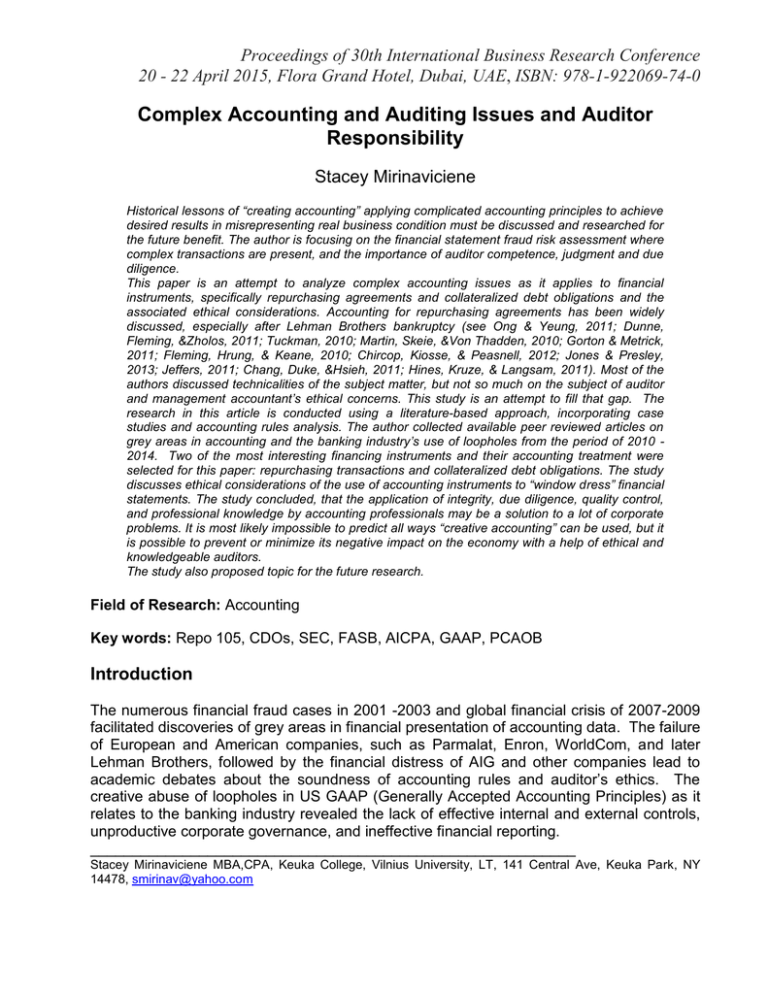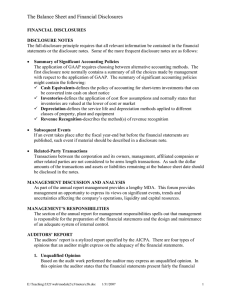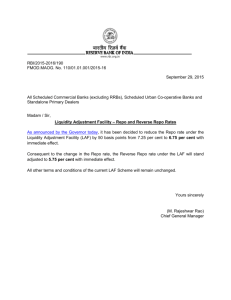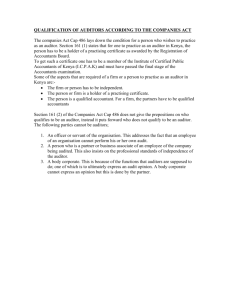Proceedings of 30th International Business Research Conference
advertisement

Proceedings of 30th International Business Research Conference 20 - 22 April 2015, Flora Grand Hotel, Dubai, UAE, ISBN: 978-1-922069-74-0 Complex Accounting and Auditing Issues and Auditor Responsibility Stacey Mirinaviciene Historical lessons of “creating accounting” applying complicated accounting principles to achieve desired results in misrepresenting real business condition must be discussed and researched for the future benefit. The author is focusing on the financial statement fraud risk assessment where complex transactions are present, and the importance of auditor competence, judgment and due diligence. This paper is an attempt to analyze complex accounting issues as it applies to financial instruments, specifically repurchasing agreements and collateralized debt obligations and the associated ethical considerations. Accounting for repurchasing agreements has been widely discussed, especially after Lehman Brothers bankruptcy (see Ong & Yeung, 2011; Dunne, Fleming, &Zholos, 2011; Tuckman, 2010; Martin, Skeie, &Von Thadden, 2010; Gorton & Metrick, 2011; Fleming, Hrung, & Keane, 2010; Chircop, Kiosse, & Peasnell, 2012; Jones & Presley, 2013; Jeffers, 2011; Chang, Duke, &Hsieh, 2011; Hines, Kruze, & Langsam, 2011). Most of the authors discussed technicalities of the subject matter, but not so much on the subject of auditor and management accountant’s ethical concerns. This study is an attempt to fill that gap. The research in this article is conducted using a literature-based approach, incorporating case studies and accounting rules analysis. The author collected available peer reviewed articles on grey areas in accounting and the banking industry’s use of loopholes from the period of 2010 2014. Two of the most interesting financing instruments and their accounting treatment were selected for this paper: repurchasing transactions and collateralized debt obligations. The study discusses ethical considerations of the use of accounting instruments to “window dress” financial statements. The study concluded, that the application of integrity, due diligence, quality control, and professional knowledge by accounting professionals may be a solution to a lot of corporate problems. It is most likely impossible to predict all ways “creative accounting” can be used, but it is possible to prevent or minimize its negative impact on the economy with a help of ethical and knowledgeable auditors. The study also proposed topic for the future research. Field of Research: Accounting Key words: Repo 105, CDOs, SEC, FASB, AICPA, GAAP, PCAOB Introduction The numerous financial fraud cases in 2001 -2003 and global financial crisis of 2007-2009 facilitated discoveries of grey areas in financial presentation of accounting data. The failure of European and American companies, such as Parmalat, Enron, WorldCom, and later Lehman Brothers, followed by the financial distress of AIG and other companies lead to academic debates about the soundness of accounting rules and auditor’s ethics. The creative abuse of loopholes in US GAAP (Generally Accepted Accounting Principles) as it relates to the banking industry revealed the lack of effective internal and external controls, unproductive corporate governance, and ineffective financial reporting. __________________________________________________________ Stacey Mirinaviciene MBA,CPA, Keuka College, Vilnius University, LT, 141 Central Ave, Keuka Park, NY 14478, smirinav@yahoo.com Proceedings of 30th International Business Research Conference 20 - 22 April 2015, Flora Grand Hotel, Dubai, UAE, ISBN: 978-1-922069-74-0 This study has several objectives. First, the author seeks to analyze a number of accounting problems associated with banking and capital markets. Second, the author seeks to discuss auditor responsibility in detecting “grey areas” and “red flags” in financial reporting. “Grey areas” in accounting are also called “creating accounting”, which means that financial statement presentation may not accurately portray actual business situation. “Red flags” in accounting are the areas representing significant risk factors effecting financial reporting. And third, the author seeks to suggest future research on the subject matter. The research in this article is conducted using a literature-based approach, incorporating case studies and accounting rules analysis. The author collected available peer reviewed articles on grey areas in accounting and the banking industry’s use of loopholes from the period of 2010 -2014. Two of the most interesting financing instruments and their accounting treatment were selected for this paper: repurchasing transactions and collateralized debt obligations. The study discusses ethical considerations of the use of accounting instruments to “window dress” financial statements. Background This study analyzed two financial instruments used in banking industry: repurchasing agreements and collateralized debt obligations. Repurchasing agreements Accounting for repurchasing agreements was originally addressed by ESP FADS 140-3, Accounting for Transfers of Financial Assets and Repurchase Financing Transactions (ASC 860-10-05-21A. These pronouncements become effective after November 15, 2008. FASB addresses the accounting for a transaction that has the following fact pattern: Party A transfers financial asset to party B, who pays cash for the asset to party A. The same time party B enters in a repurchase agreement with party A. Under this agreement party A lends cash to party B, and party B transfers financial asset as collateral for the loan to party A (Weiss, 2011). The transactions can be accounted separately if all of the following criteria are met: 1) the initial transfer and the repurchase agreement do not contractually depend on each other, 2) the initial transferor has full recourse to the transferee on default, 3) there is a quoted price in an active market for the previously transferred financial asset and a repurchase agreement, and 4) the repurchase agreement must be settled before the financial asset maturity date. If these criteria are not met, transactions are accounted as linked. The next step is to evaluate if these transactions meet the definition of sale. If transactions do not meet criteria of sale, financial assets should remain on the balance sheet of the initial lender and both parties will recognize a forward contract (Weiss, 2011). As one can see, this pronouncement is quite complicated and can be easily manipulated. The technicality behind this agreement is that very liquid financial assets are placed as collateral for short term loan. The accounting of this agreement does not create off balance sheet transactions. Both the asset and a liability remain on the books of the borrower and leverage ratios are not affected. Is this the “grey”? It wouldn’t hurt if you added another statement defining your use of grey, if that’s the case. Proceedings of 30th International Business Research Conference 20 - 22 April 2015, Flora Grand Hotel, Dubai, UAE, ISBN: 978-1-922069-74-0 Repurchasing agreements were common tools used by the large banks to improve leverage ratios by removing current liabilities at the end of reporting periods. Repo markets were used by Bank of America Corp., Deutsche Bank AG, Citigroup and others (Chang, Duke, & Hsieh, 2011). The disclosure of the significant Repo 105 transactions was not a specific requirement. The failure of Lehman Brothers firm lead to discovery of an accounting manipulation which attracted attention of many specialists’. However, Repo 105 transactions created a different effect. The cash secured from collateralized borrowings was used to retire other liabilities. This combination of sale and retirement of assets reduced total assets, liabilities, and leverage ratios (Hines, Kreuze, & Langsam, 2011). In the case of Lehman Brothers failure, the technical requirements of SFAS No.140 were met: 1) the transaction was a true sale at law (SFAS No.140.9a), the transferee had an ability to pledge or exchange transferred assets (SFAS No. 140.9b), and the transferor was considered to relinquish control of the securities transferred (SFAS No. 140.9c) (Examiner’s Report, 2010, Appendix 17, p.4). The first requirement, to prove a true sale was obtained using the opinion of a London law firm. While US law does not allow attorney opinions to prove sale, under English law it was a legal process. The third requirement, securing a confirmation of borrowings were at least 5% lower than market value of assets relinquished, was attained. The creative use of Repo 105 to improve the balance sheet and financial ratios at the end of the reporting periods created a misrepresentative picture of the financial health of Lehman Brothers. Is this the red flag? After Lehman Brothers manipulation was discovered, FASB amended FSP FAS 140-3- Accounting for Transfers of Financial Assets and Repurchase Financing Transactions by issuing FASB ASU 2011-3. According to new requirements to account for a transfer of the assets as a sale, requirements to be met include: 1) the transferred assets have been isolated from the transferor, 2) each transferee has the right to pledge or exchange the assets it received, and 3) the transferee does not maintain effective controls over transferred assets. The new regulation (ASU 2011-03) also increased disclosure requirements (Jeffers, 2011). The rule-based standards existing in US GAAP allows CFOs and accountants to use technicalities in some cases to achieve unethical results, without disclosure or punitive results. The “substance over form” principle frequently seems to be ignored (Chang, Duke, & Hsieh, 2011). While most researchers agree that the financial failures of Lehman Brothers is not a responsibility of inadequate GAAP rules, the opportunity for creative window dressing of financial statements, including a creative use of international law differences ( in this case difference between English law and US law) is a bit disturbing. It is most likely impossible to predict all the ways creative accounting can be used, but it is possible to prevent or minimize its negative impact on the economy with the help of ethical and knowledgeable auditors. According to the GAAS and AICPA code of conduct, auditors are required to follow ten standards. General standards of conduct, require adequate technical training, proficiency, an independent mental attitude, and exercise due diligence. Standards of fieldwork require adequately supervising assistants, understanding the entity and its environment, and obtaining adequate evidence (Jones & Presley, 2013). Standards of reporting require auditors to state in their reports when financial statements are in accordance with GAAP, to identify inconsistencies, inadequate Proceedings of 30th International Business Research Conference 20 - 22 April 2015, Flora Grand Hotel, Dubai, UAE, ISBN: 978-1-922069-74-0 information and to express an opinion. In Lehman Brothers instance, the highly qualified auditors, Ernst & Young, had conducted audits for at least three years prior to the discovery of the problem. These auditors did have sufficient information, including the report of the employee about his concerns, pointing on problematic use of Repo 105 (Jones & Presley, 2013). All years auditors did not find any deficiencies in Lehman Brothers financial statements. The rules were followed, but what about ethics? Collateralized debt obligations Another accounting disclosure and information communication problem was associated with Collateralized Debt Obligations (CDOs). Collateralized Debt Obligations (SDOs) was an investment tool which failed due to insufficient disclosure to investors about the composition of these investments. CDOs are investment securities created by pooling similar credit instruments, such as mortgage backed securities, loans, bonds, asset backed securities, and more. Risk and interest of these instruments depends on the structure of collateral. The main problem here is that investors did not necessary know what they invested in, because sponsor can change structure of this instrument at any time without notifying them. The pricing of these instruments is complex and frequently estimated (Michello & Deme, 2012). Bear Sterns, Citigroup, Meryl Lynch, Wachovia, and Morgan Stanley were selling and promoting CDOs, including equity trenches as stabile investments. Public pension funds, such as General Retirement System of Detroit, the Teachers Retirement System of Texas, and Missouri State Employees’ Retirement System invested millions in these risky instruments (Michello & Deme, 2012). Most of these investors relied on rating agencies, and did not perform enough due diligence in gathering information on CDOs. Collateralized Debt Obligations (SDOs) were sold in a short sale markets initiated by banks without sufficient disclosure to investors. Pricing models of these instruments were complex, did not factor in sufficient information about risks involved, and did not disclose its composition to investors. Miscommunication of pricing and risk of these instruments was affecting not only rating agencies, but underwriting departments of issuing banks. Apparently financial institutions either did not have enough technical knowledge, did not perform due diligence, or simply ignored the emerging problem. Some researchers argued that wide spread securitization of mortgage payments into complex investments, specifically CDOs, insufficient communication to investors played one of most important roles in triggering 2008 financial crisis(Michello & Deme, 2012). Insufficient disclosures and inadequate transparency of financial information as 2008-2009 events proved facilitated increased financial losses and deepened financial crisis. The table below illustrates Security and Exchange Commission (SEC) enforcement actions through September 11, 2104 Proceedings of 30th International Business Research Conference 20 - 22 April 2015, Flora Grand Hotel, Dubai, UAE, ISBN: 978-1-922069-74-0 Concealed From Investors Risks, Terms and Improper Pricing in CDOs Other Complex Structured Products Key Statistics 2011-2014 (compiled from WWW.sec.gov) Date Company 2011 Citigrop 2010-2012 Goldman Sachs Settlement $285 million $550 million 2011 JP Morgan Securities $153.6 million 2013 Merril Lynch $131.8 million 2012 Mizuho Securities USA $127.5 million 2011 WachoviaCapital Markets $11 million 2012 Wells Fargo $6.5 million 2013 UBS Securities $50 million Violation Misleading disclosure of CDOs tied to housing market Misleading disclosure of synthetic CDOs tied to subprime mortgages Misleading disclosure of synthetic CDOs tied to subprime mortgages Misleading disclosure of CDOs tied to subprime mortgages Misleading disclosure of CDOs tied to subprime mortgages Misleading disclosure of CDOs tied to subprime mortgages Misleading disclosure of CDOs tied to subprime mortgages Misleading disclosure of CDOs tied to subprime mortgages Discussion Off balance sheet transactions, revenue recognition manipulations, insufficient disclosures, or omission of disclosures all together were most commonly used financial statements manipulation tools by failed companies. Table below summarized worst accounting scandals 2001-2008. Information was derived from www.sec.org web site Proceedings of 30th International Business Research Conference 20 - 22 April 2015, Flora Grand Hotel, Dubai, UAE, ISBN: 978-1-922069-74-0 Name of the Year company 2001 Enron Losses/Misstateme Auditors nts $74billion losses Arthur Anderson 2002 WorldCom $180 billion losses 2002 TYCO $150 million losses PricewaterhouseCo opers $1.4 billion PricewaterhouseCo misstatements opers $5 billion PricewaterhouseCo misstatements opers $3,9 billion losses PricewaterhouseCo opers 2003 HealthSouth 2003 2005 American International Group (AIG) 2008 Lehman Brothers 2008 Bernie Madoff $50 billion misstatements Arthur Anderson, KPMG Accounting Manipulation Off balance sheet liabilities, earnings manipulation, insider trading Expense capitalization, fraudulent accounting entries Loan manipulation, fraudulent stock sales Fraudulent accounting entries Fraudulent accounting entries Revenue manipulation PricewaterhouseCo Off balance sheet opers transactions, revenue manipulation $64.8 billion losses Friehling & Horowitz, CPAs, P.C Ponzi scheme Despite alleged inconsistencies between US GAAP and US auditing standards, in all those cases, “red flags” should have been somewhat apparent to internal and external auditors. Auditing standards suggest auditor reliance on promulgations from authoritative bodies, but auditor should also apply “reasonable man” principle (Jones & Presley, 2013). Accounting profession require auditor to apply common sense, “substance over form” evaluation, not only rely on technical pronouncements, if they seem to be insufficient. AICPA Code of Professional Conduct require CPAs to adhere to main principles: Section 50 – principles of professional conduct, section 90 – specify rules of conduct, section 100 – independence, integrity and objectivity, section 200 – general standards of accounting principles, section 300 – responsibility to clients, section 400 – responsibility to colleagues, section 500 – other responsibilities and practices. Principles of professional conduct require accountants to accept responsibility to public interest, maintain integrity, objectivity and independence, exercise due care; maintain internal control and quality control of their work (www.aicpa.org). Institute of Management Accountants has their own code of ethics, leading internal auditors, and management accountants. All CPAs are required to maintain current knowledge of all standards by completing continuing education courses every year. We have pretty strong set of requirements for CPAs, and due diligence Proceedings of 30th International Business Research Conference 20 - 22 April 2015, Flora Grand Hotel, Dubai, UAE, ISBN: 978-1-922069-74-0 is still a large outgoing problem in auditor’s work. Public’s confidence in financial reporting, especially after these financial crises suffered huge downfall (Chang, Duke, & Hsieh, 2011). Sure, large accounting firms are busy, audits require significant amount of time, and sometimes inexperienced staff is not properly supervised. That is a quality control issue. A lot of problems could have been prevented if due diligence was applied an analyzing “red flags”, and taking onto consideration whistleblower’s complains. US House of Representatives passed Audit Integrity and Job Protection Act H.R. 1564 in July of 2013, prohibiting Public Company Accounting Oversight Board (PCAOB) from requiring mandatory audit firm rotation. The argument was that no evidence exists that mandatory audit firm rotation would enhance audit quality, and that board of directors, management, and shareholders should make that determination (www.aicpa.org). In opinion of this author such legislation may negatively influence auditor independence, objectivity, and may be quality problems. Future Research One area of concern is a transparency and disclosure of financial information. While most agree that more disclosure is needed to benefit investors, creditors and other financial statement users, it may be difficult to find a right balance between adequate transparency and protection of commercially sensitive information. More research is needed to determine also the appropriateness of use of nontraditional accounting techniques and evaluation of “red flags” in financial information. Another area that needs further investigation is the detailed analysis of causes of financial crises. Despite the fact that many research studies already exist on this subject matter, it seems to not be sufficient conclusions how to actually prevent this from happening. Enterprise –wide risk management process may be an answer and this topic would require in-depth studies. Additional research is needed evaluating management accountants and auditors professional ethics application, evaluating costs and return of implementation and mandate of strict ethical standards in business environment, as well as application of international ethics standards. Conclusion In light of financial failures of large publicly traded companies in last decade raised numerous concerns by investors, shareholders, and accountants. Despite established ethical standards, which, management accountants, internal and external auditors must adhere, financial statement fraud, misrepresentation of financial data using shady techniques are still very present, and frequently not detected on a timely manner, especially in banking industry. In analyzed cases auditors either did not exercise sufficient due diligence, or simply closed their eyes to the facts. Numerous research studies focused on GAAP loopholes, eliminating auditor responsibility to detect irregular financial reporting. Rules are necessary to follow, but common sense and due diligence must be exercised. Internal and external auditors, management accountants are in the immediate position to Proceedings of 30th International Business Research Conference 20 - 22 April 2015, Flora Grand Hotel, Dubai, UAE, ISBN: 978-1-922069-74-0 determine and at times to prevent fraud from happening. The application of integrity, due diligence, quality control, and professional knowledge by accounting professionals may be a solution to a lot of corporate problems. It is most likely impossible to predict all ways “creative accounting” can be used, but it is possible to prevent or minimize its negative impact on the economy with a help of ethical and knowledgeable auditors. References Chang, C.C., Duke, J. and Hsich, S.J. 2011. “A loophole in financial accounting: a detailed analysis of repo 105”, Journal of Applied Business Research, vol. 27, no. 5, pp. 33-39. Chircop, J., Kiosse, P.V. and Peasnell, k. 2012. “Should repurchase transactions be accounted for as sales or loans”, Accounting Horisons, vol. 26, no. 4, pp. 657-679. Dunne, P.G., Fleming, M.J. and Zholos, A. 2011, Repo market microstructure in unusual monetary policy conditions. Research Technical Papers. Available http://www.newyorkfed.org/research/conference/2010/cb/Dunne_Fleming_Zholos1.pdf. at: Examiner’s Report. 2010. Report of Anton.R. Valukas, Examiner, United States Bankruptcy Court, Southern Disctirct of New York, United States Bankrupcy Court, New York, NY. Fleming, M.J., Hrung, W.B. and Keane, F.M. 2010. “Repo market effects of the term securities lending Facility” Staff Reports 426. Gorton, G. and Metrick, A. 2011. “Securitized banking and the run on repo”, Journal f Financial Economics. Hines, C., Kreuze, J., and Langsam, S. 2011. “An analysis of Lehman Brothers bankruptcy and repo 105 transactions”, American Journal of Business, vol.26, no. 1, pp. 40-49. Jeffers, A., E. 2011. “How Lehman Brothers used repo 105 to manipulate their financial statements”, Journal of Leadership, Accountability and Ethics, vol. 8, no. 5, pp.44-55. Proceedings of 30th International Business Research Conference 20 - 22 April 2015, Flora Grand Hotel, Dubai, UAE, ISBN: 978-1-922069-74-0 Jennings, M.,M. 2011. “The irony of complicity: Lehman Brothers, Ernst & Young, and repo 105”, Corporate Finance Review, vol.16, n.6, pp. 36-41. Martin, A., Skeie, D. and Von Thadden, E.L. 2010. “Repo runs. Staff report, New York, NY: Federal reserve Bank of New York. Michello, F.,A. and Deme, M. 2012. “Communication failures, synthetic CDOs, and the 2008 financial crisis”, Academy of Accounting and Financial Studies Journal, vol. 16, no. 4, pp. 105-121. Ong, K., T, and Yeung, E.Y. 2011. “Repos and securities lending: the accounting arbitrage and their role in The global financial crisis”. Capital Markets Law Journal. Vol 6, no.1, p. 92. Rapoport, M. and McGinty, T. 2010. “Banks tri debt, obscuring risks”, The Wall Street Journal, vol. 122, May, pp.A1-A2. Truman, J.B. and Presley, T. 2013. “Law and accounting: did Lehman Brothers use of repo 105 transactions violate accounting and legal rules?” Journal of Legal, Ethical and Regulatory Issues, vol.16, no. 2, pp.55-91. Tuckman, B. 2010. “Systematic risk and the tri-party repo clearing banks”. CFS Policy Paper, New York, NY: Center of Financial Stability. Weiss, J.2011, GAAP Guide, Volume II: Restatement and Analysis of Other Current FASB, EITF, and AICPA Pronouncements, GGH, Chicago. www.aicpa.org www.sec.org



